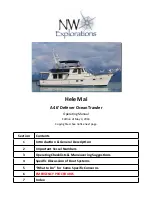
7
SAFETY MEASURES
General
To fully appreciate the pleasures,
enjoyment and excitement of boat-
ing there are some basic rules that
should be observed and followed by
any rider. Some rules may be new
to you or covered in the
Sea-Doo
Safety Handbook
or
Safety Video-
cassette
, others may be common
sense or obvious… irrespective, we
ask that you please take a few min-
utes of your time to read these safe-
ty instructions completely together
with your
Safety Handbook
before
you operate your watercraft.
Fail-
ure to follow this safety informa-
tion and safe boating rules could
result in injury, including the pos-
sibility of death to you, your pas-
senger(s), or other water users.
Bombardier recommends not to op-
erate a watercraft under the age of
16.
Become completely familiar with the
controls and operation of the water-
craft before embarking on your first
trip or taking on a passenger(s). If you
have not had the opportunity to do so
with your authorized Sea-Doo dealer,
practice driving solo in a suitable area
and feel the response of each con-
trol. Be fully familiar with all controls
before applying throttle above idle
speed. As its operator, you control
and are responsible for the water-
craft’s safe operation.
Always carry the regulatory required
safety items on board. Check the lo-
cal regulations or consult your au-
thorized Sea-Doo dealer.
Make sure that all users of the wa-
tercraft read and understand all on-
product warnings.
Operation
Always perform the pre-operation
checks as specified in this guide.
Operator and passenger(s) should at
all times wear a coast guard approved
personal flotation device (PFD) that is
suitable for personal watercraft.
Operator and passenger(s) should
wear protective clothing. Severe in-
ternal injuries can occur if water is
forced into body cavities of males or
females as a result of falling into wa-
ter or being near jet thrust nozzle.
Wet suit bottom (or thick, tightly wo-
ven, snug fitting clothing that pro-
vides equivalent protection. Thin bike
shorts for example would not be
appropriate), footwear, gloves and
goggles/glasses are recommended.
Always keep in mind that as the
throttle lever is released to idle posi-
tion, less directional control is avail-
able.
To turn the watercraft, both
steering and throttle are neces-
sary.
Like any other craft, this watercraft
has no brake. Stopping distance will
vary depending on initial speed, load,
wind, and water conditions. Practice
stopping and docking in a safe, traffic
free area to have an idea of how long
it will take to stop the watercraft un-
der varying conditions. Do not re-
lease throttle when trying to steer
away from objects. You need throttle
to steer. Do not use the watercraft’s
reverse, if so equipped, to stop.
Ensure that all passengers know
how to swim and how to reboard
the watercraft from the water.
The operator and passenger(s) should
be properly seated before starting
or moving the watercraft, and at all
times when watercraft is in motion.
smo2002-003_a.book Page 7 Friday, October 12, 2001 2:04 PM










































